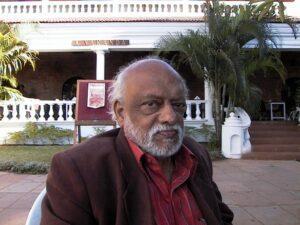Exploring the Essence of F.N. Souza
Embark on a captivating journey into the life and artistry of F.N. Souza with the latest release from Niyogi Books: F.N. Souza: The Archetypal Artist’ by Janeita Singh. This meticulously crafted publication offers a fresh perspective on the celebrated modern Indian painter, marking a departure from conventional narratives.

F.N. Souza
Released amidst anticipation in February 2024, this book is more than just a tribute to F.N. Souza; it’s an exploration of his art through a unique lens. Singh’s approach, intertwining psychoanalysis and feminism, breathes new life into Souza’s works, inviting readers to delve deeper into the complexities of his creations.
With over 130 images of Souza’s paintings, the book promises a visually engaging experience, allowing readers to witness the evolution of Souza’s artistic expression over the years. From vibrant landscapes to thought-provoking portraits, each artwork tells a story, offering glimpses into Souza’s psyche and the socio-cultural milieu of his time.
Behind the pages of this insightful publication lies years of meticulous research. Singh’s twelve-year odyssey to unravel the mysteries of Souza’s art has resulted in a collection of essays that transcend traditional boundaries. Drawing from diverse disciplines such as art history, philosophy, and psychology, Singh’s commentary offers fresh insights into Souza’s enduring relevance in the world of art.
Trisha De Niyogi, the COO of Niyogi Books, expressed her enthusiasm for the publication, highlighting its significance in shedding new light on Souza’s contributions to the art world. For her, the book represents a commitment to fostering diverse voices and perspectives in the realm of arts and literature.
F.N. Souza: The Archetypal Artist is now available in hardback format, spanning 320 pages. Priced at INR 4,500, it can be found at leading bookstores and online retailers. Join the journey of exploration as you uncover the essence of F.N. Souza’s artistry through a fresh, nuanced perspective.
Excerpt: F.N. Souza: The Archetypal Artist
Janeita Singh

Janeita Singh
I walked in one day because I saw the golden female nude through the rose-tinted window glass of the exhibition gallery. That was weird, I thought, seeing myself in the woman striking a nonchalant pose on the canvas. One might have otherwise expected the guilt-ridden,bashful Venus pudica types with a perpetual blush marking her countenance or a prevalent supine, spread-eagled, spineless she-form. They told me the famous (and in other ways infamous) artist F.N. Souza was dead.
A hush enveloped the gallery space that day. Gentle breeze wafted in playing with the blue-pink flush of sunlight through the jali wall, creating a pattern of tinged diamonds on the beige, tiled floor.
Tubular cerulean-teal benches with sleek curved legs, placed in the centre of the rooms offered ease and comfort. The canvases of varied sizes clung to the cream wall, with lemony muslin curtains fluttering here and there. Music played, tinkling and tripping like trickling water from a drinking fountain. Intermittently a babble of voices would permeate the space, reaching a peak and then ebb out.
The golden nude wasn’t pure golden yellow like the sunflower is yellow, but butterscotch bumblebee yellow. Peering closely at the impasto application of paint, I was suddenly startled to hear the nudes speak against a backdrop of a babble which had invaded the gallery space once again. I was at the receiving end, as the voices originated from varied corners of the gallery. The nudes seemed to speak together, in quick succession one after the other and
it sounded like a chant that had begun long ago, probably in the middle of the last century—a unanimous craving for someone to hear them sing. I stood rooted to the spot, primevally bewitched.
Each canvas was like the marriage bed in Donne’s poem.1 The nudes chorused that their bloods—that of the artist and their own had mingled with ‘no sin, nor shame nor loss of maidenhead’. The most powerful emotion rather was that of the terror of mutual sexualities—
obsessive drives that are generally over-heaped with myths, the mind being a palimpsest of places, culture and experiences.
The nudes chimed, what Souza liked to do was to sound his ‘barbaric yawp’ clearly and with all his might. Deeply connected to nature, he revelled in being one with the sea, the breeze, the waves, the flowers and the trees. In complete rhythm with forces of nature, animate and inanimate matter, he expressed his innate vocabulary on his canvas with vitality and vigour.
Watching those nudes that day and listening to their chant, I felt as if the whole place was being illuminated by some other earthly light. Unparalleled in history, here was an artist who really wanted to mingle and have a real conversation. Here was someone who had been privy to those hush-hush feminine affairs, where men had never wanted to go or see.
…
Great creative energies connect with each other, even if they are spread across ages. Artists and writers understand this surreal telepathic mechanism very well. Leashed by their egos, few living souls resonate with each other. But history is witness to mysterious cross connections between living and dead souls. Dante–Virgil, Joyce–Homer and Galileo–Copernicus, provide a frame for a Souza–Whitman coupling. Leaves of Grass by Walt Whitman, biblical in its expression of sexuality, exalted the human body and the material world. Half a century later when Souza arrived at a similar sexual psychotic crisis, Whitman was there: ‘I stop somewhere waiting for you’. Though William Carlos William wrote poems about Bruegel’s paintings the visual transcript in a world where image is supreme, seemed to be the more appropriate answer for Souza. Whitman held the light aloft and Souza articulated with his brushstrokes—the Whitmanian bacchanalian bash with bodily oozings and boozy bosoms. In fact Souza potentially retraced his arabesque line over each letter of Whitman’s compilation, ‘Children of Adam’, which triumphantly subverts the story of the ‘Garden of Eden’. He renewed the script from the very beginning and tattooed the modern man-woman love story through his squiggles, returning the ‘Garden of Eden’ to the children of Adam and Eve—rendering them, especially the ‘fallen woman’, bold and beautiful.
Along with Whitman’s ‘Children of Adam’ came Marc Chagall’s ‘Song of Solomon’, part of the way. In his quest Souza was fired by two opposing forces representing polarities at its best—the Asian text of Kamasutra7 and the story of the ‘Fall of Man’. But finally, the thrust may have come from the fact, that men guided by a balanced Anima, in their truest hour rendered works like Hieronymus Bosch’s The Garden of Earthly Delights and Carl Off’s scenic cantata ‘Carmina Burana’ (the ultimate drinking song). Therefore in his search for self in that art brut moment he knew he would have to take his unconscious head-on, in favour of the 2,500 years of history of ‘sins of the flesh’. Thus, he became an ‘Outsider’.
…
Beyond scopophilia, I became ‘a woman looking at Souza look at women’. Gazing at the nudes with fresh eyes, I met Dora Marsden’s ‘Freewomen’, women who had walked a long way ahead from being bondswomen—those ordinary women shackled by convention, pawns in patriarchal history (as wives, mothers, sisters, spinsters, prostitutes or other gendered selves)—giving birth to ‘individual ends in themselves’. But the lay observer groomed a voyeur on three-millennia-old patriarchal art, where female sexuality served man’s fancy, fantasy and the F word, obviously did not get it. On the contrary, they were repelled by Souza’s explicit imagery of women’s sexuality—love, lust, giving birth and sexual freedom—a human right to be her egotist self.
The Freewomen, conceived in 1911, has largely been an abstraction for entities that have been gestating for over three millennia. Freewomen are directed exclusively by their ego twined with their inner self. They are autonomous beings free to make their own choices regarding their identity and sexuality.
















